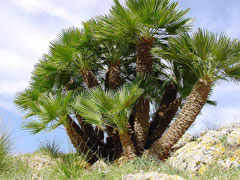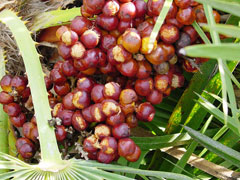 |
|
http://commons.wikimedia.org/wiki/User:Esculapio |
 |
| http://commons.wikimedia.org/wiki/User:Esculapio |
Translate this page:
Summary
Bloom Color: Yellow.
Main Bloom Time: Early spring, Late spring, Mid spring. Form: Palm, Upright or erect.
Physical Characteristics

 Chamaerops humilis is an evergreen Tree growing to 1.5 m (5ft) by 1.5 m (5ft) at a slow rate.
Chamaerops humilis is an evergreen Tree growing to 1.5 m (5ft) by 1.5 m (5ft) at a slow rate.
See above for USDA hardiness. It is hardy to UK zone 9. It is in leaf all year, in flower from April to June. The species is monoecious (individual flowers are either male or female, but both sexes can be found on the same plant).
Suitable for: light (sandy) and medium (loamy) soils, prefers well-drained soil and can grow in nutritionally poor soil. Suitable pH: mildly acid, neutral and basic (mildly alkaline) soils. It can grow in semi-shade (light woodland) or no shade. It prefers dry or moist soil and can tolerate drought.
UK Hardiness Map
US Hardiness Map
Synonyms
Plant Habitats
Woodland Garden Sunny Edge; Hedge;
Edible Uses
Edible Parts: Fruit Leaves Shoots
Edible Uses:
Very young leaf buds are cooked as a vegetable[46, 61, 105, 183]. The young shoots or suckers from the bottom of the plant are also used[2, 183]. Fruit - dried[177, 183]. No further details.
References More on Edible Uses
Medicinal Uses
Plants For A Future can not take any responsibility for any adverse effects from the use of plants. Always seek advice from a professional before using a plant medicinally.
None known
References More on Medicinal Uses
The Bookshop: Edible Plant Books
Our Latest books on Perennial Plants For Food Forests and Permaculture Gardens in paperback or digital formats.

Edible Tropical Plants
Food Forest Plants for Hotter Conditions: 250+ Plants For Tropical Food Forests & Permaculture Gardens.
More

Edible Temperate Plants
Plants for Your Food Forest: 500 Plants for Temperate Food Forests & Permaculture Gardens.
More

More Books
PFAF have eight books available in paperback and digital formats. Browse the shop for more information.
Shop Now
Other Uses
Fibre Hedge Hedge
A strong fibre obtained from the leaves is used for cordage and brushes[46, 61, 89, 100, 171, 231]. The whole leaf can be used in weaving. Plants have been used to form hedges in Mediterranean areas[260].
Special Uses
Carbon Farming Hedge Hedge
References More on Other Uses
Cultivation details
Industrial Crop: Fiber Management: Standard Regional Crop
Landscape Uses:Border, Container, Pest tolerant, Massing, Specimen. Easily grown in a rich strong loam enriched with leafmold and sand[1]. Plants grow in poor dry soils in the wild[200]. Requires very good drainage with abundant moisture in the summer and a sunny position[1, 11]. Another report says that plants grow well in dry conditions and are drought tolerant[260]. Tolerates low light levels and can be grown in the home[200]. Requires a position sheltered from the wind and cold[166]. This species tolerates occasional short-lived lows down to about -10°c[200, 231]. It will not tolerate recurring bouts of freezing over several days, nor does it survive freezing of the root system[231]. Plants are hardy in the milder areas of Britain, succeeding from S. Hampshire south and westwards[1, 11, 59]. Plants growing outdoors at Kew fruited in October 1989[K]. Palms usually have deep penetrating root systems and generally establish best when planted out at a young stage. However, older plants are substantially more cold tolerant than juvenile plants[231]. In areas at the limit of their cold tolerance, therefore, it is prudent to grow the plants in containers for some years, giving them winter protection, and only planting them into their permanent positions when sheer size dictates[231]. Palms can also be transplanted even when very large. Although the thick fleshy roots are easily damaged and/or desiccated, new roots are generally freely produced. It is important to stake the plant very firmly to prevent rock, and also to give it plenty of water until re-established - removing many of the leaves can also help[231]. Another report says that this species dislikes root disturbance[132]. Some botanists recognise a sub-species C. humilis arborescens (Pers.)Steud. (a taller growing form) and a cultivar 'Nana' which is smaller than the type and suckers. It is likely that these are no more than phenotypes and that this variety of habit can be induced in cultivation, plants in stressful situations such as near the coast duplicating the 'Nana' form whilst plants in optimum conditions are more like sub-species arborescens[200]. Plants in the wild are usually found in poor soils and seldom exceed 1.5 metres tall. When grown in better soils in gardens, however, they can grow up to 5 metres tall[260]. Special Features:Attractive foliage, Not North American native, Inconspicuous flowers or blooms.
Carbon Farming
-
Industrial Crop: Fiber
Clothing, rugs, sheets, blankets etc. Currently, almost none of our fiber are produced from perennial crops but could be!
-
Management: Standard
Plants grow to their standard height. Harvest fruit, seeds, or other products. Non-Destructive management systems.
-
Regional Crop
These crops have been domesticated and cultivated regionally but have not been adopted elsewhere and are typically not traded globally, Examples in this broad category include perennial cottons and many nuts and staple fruits.
References Carbon Farming Information and Carbon Sequestration Information
Temperature Converter
Type a value in the Celsius field to convert the value to Fahrenheit:
Fahrenheit:
The PFAF Bookshop
Plants For A Future have a number of books available in paperback and digital form. Book titles include Edible Plants, Edible Perennials, Edible Trees,Edible Shrubs, Woodland Gardening, and Temperate Food Forest Plants. Our new book is Food Forest Plants For Hotter Conditions (Tropical and Sub-Tropical).
Shop Now
Plant Propagation
Seed - best sown as soon as it is ripe, the old seed can be slow and difficult to germinate. Scarification or pre-soaking stored seed for 1 - 2 days can be helpful[133]. Sown in a warm greenhouse, the seed usually germinates in 3 - 4 months (but can take longer) at 25°c[133]. The seed produces a long root some time before a shoot appears above ground and it can be potted up at this time[164]. Grow the plants on in the greenhouse for at least a couple of years before planting them out into their permanent positions in the summer. Suckers, removed in spring.
Other Names
If available other names are mentioned here
Native Range
EUROPE: Italy (incl. Sardinia, Sicily), Spain (incl. Baleares), France, Portugal AFRICA: Algeria, Libya, Morocco, Tunisia
Weed Potential
Right plant wrong place. We are currently updating this section.
Please note that a plant may be invasive in one area but may not in your area so it's worth checking.
Conservation Status
IUCN Red List of Threatened Plants Status :

Growth: S = slow M = medium F = fast. Soil: L = light (sandy) M = medium H = heavy (clay). pH: A = acid N = neutral B = basic (alkaline). Shade: F = full shade S = semi-shade N = no shade. Moisture: D = dry M = Moist We = wet Wa = water.
Now available:
Food Forest Plants for Mediterranean Conditions
350+ Perennial Plants For Mediterranean and Drier Food Forests and Permaculture Gardens.
[Paperback and eBook]
This is the third in Plants For A Future's series of plant guides for food forests tailored to
specific climate zones. Following volumes on temperate and tropical ecosystems, this book focuses
on species suited to Mediterranean conditions—regions with hot, dry summers and cool, wet winters,
often facing the added challenge of climate change.
Read More
Expert comment
Author
L.
Botanical References
1150200
Links / References
For a list of references used on this page please go here
Readers comment
| Add a comment |
|
If you have important information about this plant that may help other users please add a comment or link below. Only comments or links that are felt to be directly relevant to a plant will be included. If you think a comment/link or information contained on this page is inaccurate or misleading we would welcome your feedback at [email protected]. If you have questions about a plant please use the Forum on this website as we do not have the resources to answer questions ourselves.
* Please note: the comments by website users are not necessarily those held by PFAF and may give misleading or inaccurate information.
To leave a comment please Register or login here All comments need to be approved so will not appear immediately.
|
Subject : Chamaerops humilis
|
|
|
|